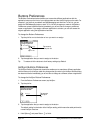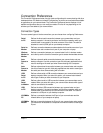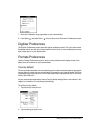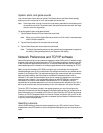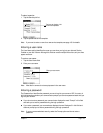
Chapter 7 Page 173
Connection Preferences
The Connection Preferences screen lets you create configurations for communicating with other
hardware devices: PC, Modem, or Infrared. Configurations, or profiles, once activated are available
to applications on your communicator. The Connection Preferences screen displays a list of
available configurations that you can modify as needed. This list will vary depending on the
software you have added to your communicator.
Connection Types
There are several types of device connections you can choose when configuring Preferences:
Serial
to PC
Defines the direct serial connection between your communicator and your
desktop computer. It is used to perform a local HotSync operation when your
communicator is connected by its serial connector to the cable. The cable is
attached to a serial (COM) port on your desktop computer.
Serial to
Modem
Defines a connection between a modem attached to the serial connector of your
communicator and a modem that is part of your computer or laptop.
Wireless
Modem to
Modem
Defines a connection between your communicator’s built-in wireless modem
and a dial-up service. Use this connection type to access wireless data services.
Auto
Detect to
PC
Defines a dynamic serial connection between your communicator and your
desktop computer. Use this connection type with third-party applications that
need to reconfigure the serial port when communicating with a computer.
Auto
Detect to
Modem
Defines a dynamic serial connection between your communicator and a modem.
Use this connection type with third-party applications that need to reconfigure
the serial port when communicating with a modem.
USB/
Serial
to PC
Defines a direct serial or USB connection between your communicator and your
desktop computer. When you select this option, your communicator detects
which type of cable you have connected to your computer.
USB/
Serial
to Modem
Defines a direct serial or USB connection between your communicator and a
modem. When you select this option, your communicator detects which type of
cable is connected to the modem.
USB
to PC
Defines the direct USB connection between your communicator and your
desktop computer. It is used to perform a local HotSync operation when your
communicator is connected by its USB connector to the cable. The cable is
attached to a USB port on your desktop computer.
IrCOMM to
PC
Defines a connection between the IR port of your communicator and the
infrared device of your computer or laptop.
IrCOMM to
Modem
Defines a connection between the IR port of your communicator and a modem.
The modem can be attached to a computer or some other device containing an
IR port.










